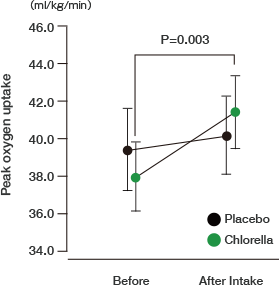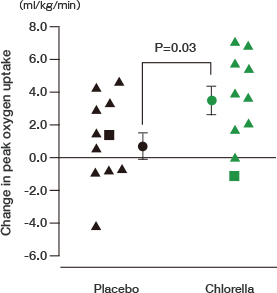Chlorella research report
- HOME
- Research report
- Chlorella research report

The Dinector of "Society for Chlorella and Functional Plants Research"
President of Research Institute of Mycology and Pharmacology
Takeshi Otsuki, Professor

Improvement of aerobic capacity by chlorella intake
(Umemoto S and Otsuki T. Chlorella-derived multicomponent supplementation increases aerobic endurance capacity in young individuals. Journal of Clinical Biochemistry and Nutrition 2014, Vo.55, No.2.)
Aerobic capacity and health
Aerobic capacity, also known as general endurance, is a key for athletes such as medium-distance run, marathon, and football. In addition, aerobic capacity is important for the middle-aged people to promote health, and it has been shown that the decline in aerobic capacity with age is associated with increased fatigue as well as morbidity and mortality from lifestyle diseases and cardiovascular diseases [References 1 and 2].
"Maximal oxygen uptake" is a representative index of aerobic capacity (general endurance). The maximal oxygen uptake is "the maximum amount of oxygen available per minute," expressed as per kilogram of body weight (mL/kg/min). Oxygen is used to produce energy in the body, and the higher oxygen utilization capacity is, the more energy it can produce, and thus you are less tired and can exercise longer.
The "Physical activity guideline for health promotion 2013 (Ministry of Health, Labour and Welfare)" specifies reference values by gender and age group (Table 1), and describes “It is necessary to improve physical strength by establishing appropriate exercise habits."
Table 1. Reference values for maximal oxygen uptake by gender and age group
| Age | 18 to 39 years | 40 to 59 years | 60 to 69 years |
| Men | 39 mL/kg/min | 35 mL/kg/min | 32 mL/kg/min |
| Women | 33 mL/kg/min | 30 mL/kg/min | 26 mL/kg/min |
A previous animal study reported that the maximal swimming time was prolonged after 14 days on a diet containing chlorella compared with on a normal diet in mice. Thus, we examined the effect of chlorella intake on the maximal oxygen uptake in this study.
Methods
A double-blind, placebo-controlled, crossover study was conducted in 10 healthy subjects (aged 21 ± 0.3 years) consisting of 7 men and 3 women. Each subject received 4 weeks of placebo and 4 weeks of chlorella with at least 6-week washout period between courses. The intake order of each subject was determined randomly, and the subjects took 30 tablets per day (15 tablets twice daily, at breakfast and dinner) during the intake period. Before and after intake, maximal exercise testing to exhaustion was performed with a bicycle ergometer, and breath gas analyzers were used to measure oxygen intake and carbon dioxide output per breath (breath-by-breath).This study was conducted with the approval of the ethical review committee of Ryutsu Keizai University.
Results and discussion
Before intake, there was no significant difference in parameters including peak oxygen uptake between the placebo and chlorella groups. After intake, there was no significant change in peak oxygen uptake in the placebo group but a significant increase in the chlorella group (Figure 1).
The results of this study showed that 4 weeks of chlorella intake increased the peak oxygen uptake during exercise, suggesting that chlorella is a food that increases general endurance.


Figure 1. Peak oxygen uptake before and after Chlorella or placebo intake and changes in maximal oxygen uptake with chlorella or placebo intake
Circles indicate mean ± SE error. Triangles indicate the data of subjects who achieved maximal exertion during both pre- and post-intake exercise testing. Squares indicate the data of subjects who did not achieve maximal exertion during post-intake exercise testing.
Reference 1. Kodama S, et al. Cardiorespiratory fitness as a quantitative predictor of all-cause mortality and cardiovascular events in healthy men and women: a meta-analysis. JAMA. 2009, 301(19): 2024-35.
Reference 2. Carnethon MR, et al. Prevalence and cardiovascular disease correlates of low cardiorespiratory fitness in adolescents and adults. JAMA. 2005, 294(23): 2981-8.


